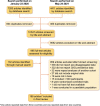Sex differences in chronic kidney disease prevalence in Asia: a systematic review and meta-analysis
- PMID: 35664281
- PMCID: PMC9155252
- DOI: 10.1093/ckj/sfac030
Sex differences in chronic kidney disease prevalence in Asia: a systematic review and meta-analysis
Abstract
Background: Previous reports on the prevalence of chronic kidney disease (CKD) in Asia have suggested important sex disparities but have been inconsistent in nature. We sought to synthesize available sex-disaggregated CKD prevalence data in Asia to quantify sex disparities in the region.
Methods: We systematically searched MEDLINE and Embase for observational studies involving ≥500 adults who reported sex-disaggregated CKD prevalence data in any of the 26 countries in East, Southeast and South Asia. For each study we calculated the female:male prevalence ratio (PR), with a ratio >1 indicating a higher female prevalence. For each country, log-transformed PRs were pooled using random effects meta-analysis. These were then combined using a fixed effects model, weighting by population size, to estimate a pooled PR for each of East, Southeast and South Asia and Asia overall.
Results: Sex-disaggregated data were available from 171 cohorts, spanning 15 countries and comprising 2 550 169 females and 2 595 299 males. Most studies (75.4%) came from East Asia (China, Taiwan, Japan and South Korea). Across Asia, CKD prevalence was higher in females {pooled prevalence 13.0% [95% confidence interval (CI) 11.3-14.9]} compared with males [pooled prevalence 12.1% (95% CI 10.3-14.1)], with a pooled PR of 1.07 (95% CI 0.99-1.17). Substantial heterogeneity was observed between countries. The pooled PRs for East, Southeast and South Asia were 1.11 (95% CI 1.02-1.21), 1.09 (0.88-1.36) and 1.03 (0.87-1.22), respectively.
Conclusions: Current evidence suggests considerable between-country and -region heterogeneity in the female:male PR of CKD. However, there remains a large part of the region where data on sex-specific CKD prevalence are absent or limited. Country-level assessment of the differential burden of CKD in females and males is needed to define locally relevant policies that address the needs of both sexes.
Keywords: CKD; albuminuria; epidemiology; gender; systematic review.
© The Author(s) 2022. Published by Oxford University Press on behalf of the ERA.
Figures



References
-
- Levey AS, de Jong PE, Coresh Jet al. . The definition, classification, and prognosis of chronic kidney disease: a KDIGO Controversies Conference report. Kidney Int 2011; 80: 17–28 - PubMed
-
- Park JI, Baek H, Jung HH. CKD and health-related quality of life: the Korea National Health and Nutrition Examination Survey. Am J Kidney Dis 2016; 67: 851–860 - PubMed
LinkOut - more resources
Full Text Sources
Research Materials

